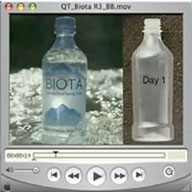BIOTA's "WATER 101: Know Your Bottled Water Facts"
What are the different types of bottled water?
Savvy consumers know all bottled waters are not the same. Different sources, bottling techniques and other issues define how the label on the water appears to consumers. The U.S. Food and Drug Administration in 1996 established a "Standard of Identity" to define different types of bottled water, based on specific characteristics. These types include:
Spring Water: Spring Water flows from an underground formation and naturally emerges to the earth's surface. To be classified as Spring Water, the water must be collected only at the spring or through a borehole tapping the underground formation. BIOTA fits into this class of bottled water.
Purified Water: Also can be labeled as "Distilled Water." This category of water has been produced by distillation, deionization, or reverse osmosis purification methods to meet the U.S. definition of purified water.
Mineral Water: Mineral water is defined as bottled water containing no fewer than 250 parts per million total dissolved solids. Mineral waters contain a constant level and proportion on mineral and trace elements at the point of emergence from the source. Bottlers may not supplement this water with minerals.
Artesian Water: Also labeled as Artesian Well Water. This name was derived from the French word, which describes water wells in the region of Artois, France. These wells are created when natural pressure from the earth's formations pushes water from a confined underground layer of rock or sand enough to force the water to flow to the earth's surface.
Well Water: Bottled water from a hole bored or drilled into the ground, which taps into water trapped in aquifers beneath layers of earth below.
What is an aquifer?
An aquifer is an underground rock formation that holds water. "Confined" aquifers are under pressure, and when the formation is tapped, the water will flow to the surface. An "unconfined" aquifer's water surface is at atmospheric pressure, and is unable to rise and fall.
BIOTA BOTTLED WATER QUALITY REPORT
Our bottled water meets all federal and state health standards. FDA regulates bottled water as a food product whereas EPA regulates tap water as provided by water utilities. Standards of quality enacted by the FDA for bottled water must be as protective of the public health as EPA's standards (known as Maximum Contaminant Levels) for tap water. Ensuring the safety of the water is our primary objective in providing our product to the consumer.
OUR SOURCE FOR OUR WATER
BIOTA Brands of America, Inc. uses a protected natural spring as the source of our water. This spring brings water to the surface from aquifers below the surface. The water in these aquifers begins as rain and snow high up in the mountains, and it remains underground until we bring it to the surface. Layers of solid rock and clay provide an impervious (not-passable) protective cover for the aquifer water. This source water is completely safe to drink. We test our source regularly to verify that the quality remains extremely high.
HOW BOTTLED WATER IS PREPARED
Our Premium Spring water is protected by a multi-barrier approach that includes source protection and monitoring, micron filtration, ozonation and the application of ultraviolet light. Our natural spring water comes from a protected source which is monitored frequently.
Our Spring Water comes from protected springs and contains less than 0.5 milligrams of sodium per 8 ounce serving. It is filtered through micron filtration to screen natural particulates.
All of our bottled water products are ozonated. We use ozone instead of chlorine because it leaves no residue, and it does not leave any taste or odor. Ozone is oxygen (O3 to be exact) which is bubbled through the water just before it goes into a clean, sanitized bottle. Within a few hours after the bottle has been filled and capped, the ozone dissipates or converts back to the same form of oxygen that we breathe (O2).
BIOTA SPECIFIC MINERAL ANALYSIS
Bicarbonate: 62 mg/L
Calcium: 96 mg/L
Chloride: 2.2 mg/L
Fluoride: 0.3 mg/L
Magnesium: 2.5 mg/L
Sodium:3.0 mg/L
Sulfate: 96 mg/L
Total Dissolved Solids:200 mg/L
Alkalinity:62 mg/L
Conductivity: 320microS/cm
pH: 7.3SU


